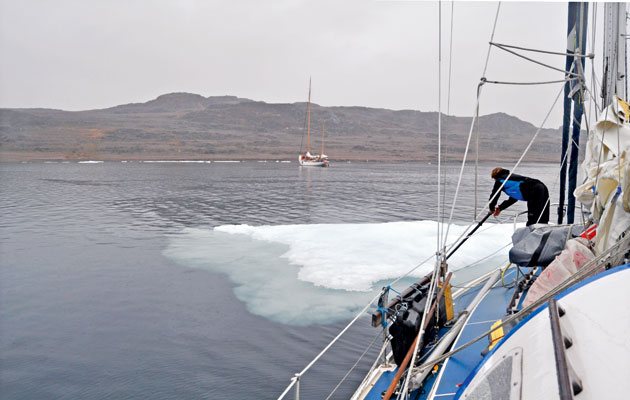Bob Shepton finds a handy haven in the icy wilderness of the North West Passage, Canada, with a choice of inlets and bays for shelter from any wind direction
The Tasmania Islands off the Boothia Peninsula is a convenient anchorage for a number of reasons. It has kudos: the Boothia Peninsula is the most northerly point of the whole American continent, so you can ‘dine out’ on the tale for months afterwards. It is also a convenient stopping point after the exigencies of the Bellot Strait with its infamous Magpie Rock, or after the struggle to get into Peel Sound (10/10ths ice for the whole of the summer of 2013) as an alternative. It is also about halfway between these obstacles and Cambridge Bay, the friendly, well stocked settlement, itself considered the halfway point of the North West Passage, psychologically at least.
We were forced to stop here anyway on our east-west passage in 2012. We had come down Peel Sound with no problems, but the ice charts showed 9/10ths ice stretching right across Victoria Sound where Franklin’s ships had got trapped in 1846, and also blocking off Amundsen’s Gjoahavn on King William Island, where Franklin’s men had eaten bits of each other in the last stages of starvation, whatever Charles Dickens may have said about it by way of denial for Victorian society. We had gone further south, come up to the ice, turned back and gone through the Shotland Channel, a useful short cut even if just passing straight through, and anchored in the first bay round the corner to port (west) where we found the classic yacht Nordwind also waiting.
One of the advantages of the Tasmania Islands is there are plenty of inlets or bays to choose from, according to the wind direction. We put our anchor down on the east side of the bay; it was as well that we did because that night it blew a strong gale from the east. We had 50 metres of chain out and a strop on the chain and were fine. Nordwind, further west in the bay, were not so fortunate: in the middle of the night the chain shot off the winch (there was no strop) and 90 metres of chain fell to the bottom. The German owner, who had lovingly restored the yacht, keeping the original anchor and chain, was not pleased with the poor skipper, but the owner subsequently helped the prop shaft slip out of the gear box by revving too hard. We waited and helped with the protracted search, dragging the seabed for the anchor and chain without success. We found one disadvantage of the islands; kelp is a very terrible thing.
We put in here again on our west/east passage in 2013. I had expected to anchor in the same place but there was more ice around this time and the wind was in the west. We also discovered that the shores could be incredibly steep-to. But we had a wide choice and ended up in a cove well to the west, in shallow water with a sandy beach. Idyllic, except for the unpredictable tidal currents bringing ice floes around at will. After some drama disentangling a large, obstinate floe, we moved closer to shore and enjoyed a good night’s sleep, keeping an anchor watch.
No pubs or restaurants, but you will need this anchorage because it is far too crowded sailing in Europe these days…






